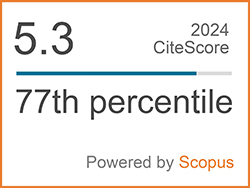Cationic Nanocellulose as Promising Candidate for Filtration Material of COVID-19: A Perspective
Abstract
Keywords
[1] WHO, “WHO | Pneumonia of unknown cause – China,” (2020). Available: http://www.who.int/csr/ don/05-january-2020-pneumonia-of-unkowncause- china/en/
[2] J. Zheng, “SARS-coV-2: An emerging coronavirus that causes a global threat,” International Journal of Biological Sciences, vol. 16, no. 10, pp. 1678– 1685, 2020, doi: 10.7150/ijbs.45053.
[3] W. W. F. Leung and Q. Sun, “Electrostatic charged nanofiber filter for filtering airborne novel coronavirus (COVID-19) and nano-aerosols,” Separation and Purification Technology, vol. 250, no. 1, 2020, doi: 10.1016/j.seppur.2020.116886.
[4] H. Dhouibi, “Surgical Masks, Respirators, Face Shields: Which Masks Actually Protect Against Coronavirus?,” (2020). Available: http://emag. medicalexpo.com/which-masks-actually-protectagainst- coronavirus/
[5] R. A. Ilyas, S. M. Sapuan, R. Ibrahim, M. S. N. Atikah, M. R. M. Asyraf, M. N. F. Norrrahim, S. O. A. SaifulAzry, and Z. M. A. Ainun, “Environmental advantages and challenges of bio-based packaging materials,” in Bio-Based Packaging: Material, Environmental and Economic Aspects. New Jersey: Wiley, 2021.
[6] M. N. F. Norrrahim, M. N. Norizan, M. A. Jenol, M. A. A. Farid, N. Janudin, F. A. Ujang, T. A. T. Yasim-Anuar, S. U. F. S. Najmuddin, and R. A. Ilyas, “Emerging development on nanocellulose as antimicrobial material: An overview,” Materials Advances, 2021, doi: 10.1039/D1MA00116G.
[7] I. M. Fareez, A. H. Jasni, and M. N. F. Norrrahim, “Nanofibrillated cellulose based bio-phenolic composites,” in Phenolic Polymers Based Composite Materials. Singapore: Springer, 2020, pp. 139–151.
[8] M. N. F. Norrrahim, N. A. M. Kasim, V. F. Knight, N. A. Halim, N. A. A. Shah, S. A. M. Noor, S. H. Jamal, K. K. Ong, W. M. Z. W. Yunus, M. A. A. Farid, M. A. Jenol, and R. A. Ilyas, “Performance evaluation of cellulose nanofiber reinforced polymer composites,” Functional Composites and Structures, vol. 3, 2021, doi: 10.1088/2631- 6331/abeef6.
[9] M. N. F. Norrrahim, H. Ariffin, T. A. T. Yasim- Anuar, M. A. Hassan, N. A. Ibrahim, W. M. Z. W. Yunus, and H. Nishida, “Performance evaluation of cellulose nanofiber with residual hemicellulose as a nanofiller in polypropylene-based nanocomposite,” Polymers, vol. 13, no. 7, p. 1064, 2021.
[10] S. M. Rangappa, S. Siengchin, and H. N. Dhakal, “Green-composites: Ecofriendly and sustainability,” Applied Science and Engineering Progress, vol. 13, no. 3, pp. 183–184, 2020, doi: 10.14416/j.asep. 2020.06.001.
[11] M. Jawaid and S. Siengchin, “Hybrid composites: A versatile materials for future,” Applied Science and Engineering Progress, vol. 12, no. 4, pp. 223– 223, 2019, doi: 10.14416/j.asep.2019.09.002.
[12] S. M. K. Thiagamani, S. Krishnasamy, and S. Siengchin, “Challenges of biodegradable polymers: An environmental perspective,” Applied Science and Engineering Progress, vol. 12, no. 3, pp. 149–149, 2019, doi: 10.14416/j.asep. 2019.03.002.
[13] M. N. F. Norrrahim, N. A. Ahmad Shah, S. H. Jamal, W. M. Z. Yunus, V. F. Knight, and N. A. M. Kasim, “Nanocellulose-based filters as novel barrier systems for chemical warfare agents,” Solid State Phenomena, vol. 317, pp. 180–186, 2021.
[14] N. S. Sharip, T. A. T. Yasim-Anuar, M. N. F. Norrrahim, S. S. Shazleen, N. M. Nurazzi, S. M. Sapuan, and R. A. Ilyas, “A review on nanocellulose composites in biomedical application,” in Composites in Biomedical Applications. Florida: CRC Press, 2020, pp. 161–190.
[15] T. A. T. Yasim-Anuar, H. Ariffin, M. N. F. Norrrahim, M. A. Hassan, Y. Andou, T. Tsukegi, and H. Nishida, “Well-dispersed cellulose nanofiber in low density polyethylene nanocomposite by liquid-assisted extrusion,” Polymers, vol. 12, pp. 1–17, 2020.
[16] R. Ilyas, S. Sapuan, A. Kadier, M. S. Kalil, R. Ibrahim, M. Atikah, N. M. Nurazzi, A. Nazrin, C. Lee, M. N. F. Norrrahim, N. H. Sari, E. Syafri, H. Abral, L. Jasmani, and M. Ibrahim, “Properties and characterization of PLA, PHA, and other types of biopolymer composites,” in Advanced Processing, Properties, and Applications of Starch and Other Bio-Based Polymers. Amsterdam, Netherlands: Elsevier, 2020, pp. 111–138.
[17] G. Metreveli, L. Wågberg, E. Emmoth, S. Belák, M. Strømme, and A. Mihranyan, “A sizeexclusion nanocellulose filter paper for virus removal,” Advanced Healthcare Materials, vol. 3, no. 10, pp. 1546–1550, 2014, doi: 10.1002/ adhm.201300641.
[18] J.-M. Kim, Y.-S. Chung, H. J. Jo, N.-J. Lee, M. S. Kim, S. H. Woo, S. Park, J. W. Kim, H. M. Kim, and M.-G. Han, “Identification of Coronavirus isolated from a patient in Korea with COVID-19 Osong public health and research perspectives,” Public Health Res Perspect, vol. 11, no. 1, pp. 3–7, 2020.
[19] E. A. J Alsaadi and I. M. Jones, “Membrane binding proteins of coronaviruses,” Future Virology, vol. 14, no. 4, pp. 275–286, 2019, doi: 10.2217/ fvl-2018-0144.
[20] M. Kaushik, C. Fraschini, G. Chauve, J.-L. Putaux, and A. Moores, “Transmission electron microscopy for the characterization of cellulose nanocrystals,” in The Transmission Electron Microscope - Theory and Applications. London, UK: IntechOpen, 2015, pp. 130–163. doi: 10.5772/ 60985.
[21] M. N. F. Norrrahim, H. Ariffin, M. A. Hassan, N. A. Ibrahim, W. M. Z. W. Yunus, and H. Nishida, “Utilisation of superheated steam in oil palm biomass pretreatment process for reduced chemical use and enhanced cellulose nanofibre production,” International Journal of Nanotechnology, vol. 16, pp. 668–679, 2019.
[22] T. A. T. Yasim-anuar, H. Ariffin, M. N. F. Norrrahim, and M. A. Hassan, “Factors affecting spinnability of oil palm mesocarp fiber cellulose solution for the production of microfiber,” BioResources, vol. 12, no. 1, pp. 715–734, 2017.
[23] R. A. Ilyas, S. M. Sapuan, R. Ibrahim, H. Abral, M. R. Ishak, E. S. Zainudin, M. S. N. Atikah, N. Mohd Nurazzi, A. Atiqah, M. N. M. Ansari, E. Syafri, M. Asrofi, N. H. Sari, and R. Jumaidin, “Effect of sugar palm nanofibrillated cellulose concentrations on morphological, mechanical and physical properties of biodegradable films based on agro-waste sugar palm (Arenga pinnata (Wurmb.) Merr) starch,” Journal of Materials Research and Technology, vol. 8, no. 5, pp. 4819– 4830, Sep. 2019, doi: 10.1016/j.jmrt.2019.08.028.
[24] R. A. Ilyas, S. M. Sapuan, M. R. Ishak, and E. S. Zainudin, “Sugar palm nanofibrillated cellulose (Arenga pinnata (Wurmb.) Merr): Effect of cycles on their yield, physic-chemical, morphological and thermal behavior,” International Journal of Biological Macromolecules, vol. 123, pp. 379–388, Feb. 2019, doi: 10.1016/j.ijbiomac.2018.11.124.
[25] R. Ilyas, S. Sapuan, M. Atikah, M. Asyraf, S. A. Rafiqah, H. Aisyah, N. M. Nurazzi, and M. Norrrahim, “Effect of hydrolysis time on the morphological, physical, chemical, and thermal behavior of sugar palm nanocrystalline cellulose (Arenga pinnata (Wurmb.) Merr),” Textile Research Journal, vol. 91, no. 1–2, pp. 152–167, Jan. 2021, doi: 10.1177/0040517520932393.
[26] A. A. B. Omran, A. A. B. A. Mohammed, S. M. Sapuan, R. A. Ilyas, M. R. M. Asyraf, S. S. R. Koloor, and M. Petrů, “Micro- and nanocellulose in polymer composite materials: A review,” Polymers, vol. 13, no. 2, p. 231, Jan. 2021, doi: 10.3390/polym13020231.
[27] M. N. F. Norrrahim, T. A. T. Yasim-Anuar, S. M. Sapuan, R. A. Ilyas, M. I. Hakimi, S. U. F. S. Najmuddin, and M. A. Jenol, “Nanocellulose reinforced polypropylene and polyethylene composite for packaging application,” in Bio- Based Packaging: Material, Environmental and Economic Aspects. New Jersey: Wiley, 2021.
[28] M. N. F. Norrrahim, N. A. M. Kasim, V. F. Knight, M. S. M. Misenan, N. Janudin, N. A. A. Shah, N. Kasim, W. Y. W. Yusoff, S. A. M. Noor, S. H. Jamal, K. K. Ong, and W. M. Z. W. Yunus, “Nanocellulose: A bioadsorbent for chemical contaminant remediation,” RSC Advances, vol. 11, pp. 7347– 7368, 2021, doi: 10.1039/D0RA08005E.
[29] R. Sunasee and U. D. Hemraz, “Synthetic strategies for the fabrication of cationic surfacemodified cellulose nanocrystals,” Fibers, vol. 6, no. 1, pp. 1–19, 2018, doi: 10.3390/FIB6010015.
[30] N. Lin and A. Dufresne, “Nanoscale preparation, properties and applications of polysaccharide nanocrystals in advanced functional nanomaterials: A review,” Nanoscale, vol. 4, pp. 3274–3294, 2012.
[31] M. N. F. Norrrahim, H. Ariffin, T. A. T. Yasim- Anuar, F. Ghaemi, M. A. Hassan, N. A. Ibrahim, J. L. H. Ngee, and W. M. Z. W. Yunus, “Superheated steam pretreatment of cellulose affects its electrospinnability for microfibrillated cellulose production,” Cellulose, vol. 25, no. 7, pp. 3853–3859, 2018, doi: 10.1007/s10570-018- 1859-3.
[32] H. Voisin, L. Bergström, P. Liu, and A. Mathew, “Nanocellulose-based materials for water purification,” Nanomaterials, vol. 7, no. 3, pp. 1–19, 2017, doi: 10.3390/nano7030057.
[33] M. N. F. Norrrahim, N. A. M. Kasim, V. F. Knight, F. A. Ujang, N. Janudin, M. A. I. A. Razak, N. A. A. Shah, S. A. M. Noor, S. H. Jamal, K. K. Ong, and W. M. Z. W. Yunus, “Nanocellulose: the next super versatile material for the Military,” Materials Advances, 2021, doi: 10.1039/ D0MA01011A.
[34] N. Mahfoudhi and S. Boufi, “Nanocellulose as a novel nanostructured adsorbent for environmental remediation: A review,” Cellulose, vol. 24, no. 3, pp. 1171–1197, 2017, doi: 10.1007/s10570- 017-1194-0.
[35] R. Rusli and S. J. Eichhorn, “Determination of the stiffness of cellulose nanowhiskers and the fiber- matrix interface in a nanocomposite using Raman spectroscopy determination of the stiffness of cellulose nanowhiskers and the fiber-matrix interface in a nanocomposite using Raman spectroscopy,” Applied Physics Letters, vol. 93, no. 033111, pp. 1–3, 2008.
[36] T. Nguyen, F. A. Roddick, and L. Fan, “Biofouling of water treatment membranes: A review of the underlying causes, monitoring techniques and control measures,” Membranes, vol. 2, pp. 804– 840, 2012, doi: 10.3390/membranes2040804.
[37] E. E. Jaekel, J. A. Sirviö, M. Antonietti, and S. Filonenko, “One-step method for the preparation of cationic nanocellulose in reactive eutectic media,” Green Chemistry, vol. 23, no. 6, pp. 2317– 2323, 2021.
[38] X. Mi, S. M. Albukhari, C. L. Heldt, and P. A. Heiden, “Virus and chlorine adsorption onto guanidine modified cellulose nanofibers using covalent and hydrogen bonding,” Carbohydrate Research, vol. 498, 2020, doi: 10.1016/jcarres. 2020.108153.
[39] C. Meingast and C. L. Heldt, “Arginine-enveloped virus inactivation and potential mechanisms,” Biotechnology Progress, vol. 30, no. 1, pp. 108– 112, 2020, doi: 10.1002/btpr.2931. [40] H. Rosilo, J. R. McKee, E. Kontturi, T. Koho, V. P. Hytönen, O. Ikkala, and M. A. Kostiainen, “Cationic polymer brush-modified cellulose nanocrystals for high-affinity virus binding,” Nanoscale, vol. 6, no. 20, pp. 11871–11881, 2014, doi: 10.1039/c4nr03584d.
[41] G. N. Rivière, A. Korpi, M. H. Sipponen, T. Zou, M. A. Kostiainen, and M. Österberg, “Agglomeration of viruses by Cationic Lignin particles for facilitated water purification,” ACS Sustainable Chemistry and Engineering, vol. 8, no. 10, pp. 4167–4177, 2020, doi: 10.1021/ acssuschemeng.9b06915.
[42] M. Sun, H. Wang, and X. Li, “Modification of cellulose microfibers by polyglutamic acid and mesoporous silica nanoparticles for Enterovirus 71 adsorption,” Materials Letters, vol. 277, p. 128320, 2020, doi: 10.1016/j.matlet. 2020.128320.
[43] S. C. Patankar and S. Renneckar, “Greener synthesis of nanofibrillated cellulose using magnetically separable TEMPO nanocatalyst,” Green Chemistry, vol. 19, no. 20, pp. 4792–4797, 2017.
DOI: 10.14416/j.asep.2021.08.004
Refbacks
- There are currently no refbacks.
 Applied Science and Engineering Progress
Applied Science and Engineering Progress







